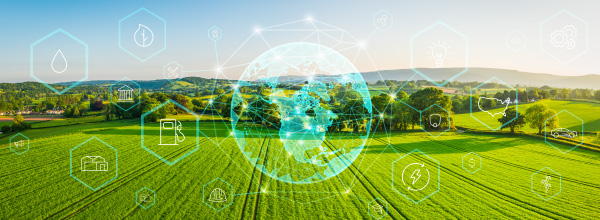Picture this: the year is 2050. We live in a world of optimal sustainability. Everyone gets a personal carbon goal and considers the carbon cost of everything we use. Companies have reached most of their sustainability goals, and they are helping consumers reach their own goals as well. Nations have worked together to achieve 90% clean energy worldwide. Automobiles, trucks, planes, and ships can run on 100% renewable fuels, and global markets have switched out petroleum for plant-based components in most consumer products.
Advances in technology have made cars incredibly energy efficient. Still, with more people and more cars, demand for biofuels is at an all-time high. Biofuel producers are helping to keep energy affordable for consumers in this high-demand scenario by ramping up production from multiple renewable resources.
In this world, there is no “throwing away,” and very little goes to waste. Raw materials have become scarcer despite leaders’ best efforts, so refuse is either remanufactured, reused, or repurposed to produce energy, clothing, construction materials, and a host of other goods. Biofuel producers are answering that call by producing more energy and bio-based products from crop waste, and even food and household waste.
Imagining this hypothetical future can be both bewildering and exciting. The reality is that the future will either be extremely challenging or full of opportunity, depending on our level of preparedness for what awaits us. Using our imaginations to visualize the planet in 2050 isn’t just science fiction fun; it helps us work toward a best-case scenario for our children and grandchildren.
If we play our cards right, the future doesn’t have to be a guessing game. We have the resources available today that can help us to preserve our planet for tomorrow.
That’s why in September 2021, POET launched its inaugural sustainability report. The report goes beyond bioethanol’s already-impressive sustainability record. It focuses on the future — outlining goals such as achieving carbon neutrality by 2050 and increased use of plant-based products, as well as advocating for public policy that advances a
sustainable society.
POET is committed to imagining and, more importantly, creating that sustainable future, says Neil Anderson, the company’s Vice President of Strategic Development.
“In order for society to stop the trend of increasing temperatures and climate change, we need to identify technologies and materials that do not release fossil CO2 when processed,” Anderson says. “This is where POET and biofuels play such an important role. We need to increase the use of plant-based fuels and materials.”
POET is well-positioned to achieve its vision for 2050 — and could get there even sooner, according to Matt Braun, Senior Vice President and General Manager of POET Bioprocessing. Braun oversees operations at all of POET’s bioprocessing plants, so he is as well-versed as anyone can be on how the company and its facilities are leading the way to a more sustainable world.
And POET can serve an even greater purpose in this eco-friendly vision for the future.
POET already produces several plant-based bioproducts that can replace their petroleum-based counterparts. The POET plant of 2050 might produce ingredients for the athletic wear a person wears for a morning workout, the cosmetics applied in the morning, the fuels that power their vehicle for the drive to work, the hand sanitizer and cleaning products that keep them healthy, the feed that helped produce their turkey sandwich for lunch, and the flight they catch for a weekend getaway.
It might make power and feedstocks for other types of power. It might make liquid fuels for aviation and the marine industry. As a matter of fact, the company’s vision is to fuel vehicles on land, air, and sea—cleanly, efficiently
and sustainably.
Can we reduce emissions of the greenhouse gases that are contributing to climate change without giving up our quality of life? Vision is about seeing the future you want to create, and POET has no shortage of visionaries. So, what does that vision look like at a POET bioprocessing facility?
At one plant, the team might focus on improving the sustainability of the inputs needed for bioprocessing. Braun says agricultural practices account for a significant portion of POET’s carbon intensity, so its farmer-suppliers will play an enormous role in reducing the carbon footprint of the company’s products. The POET plant of the future would incentivize even more farmers to use even more climate-smart agricultural practices, such as precision and no-till farming, to sequester more carbon in the soil.
POET currently has about 40,000 farmers delivering grain to its bioprocessing plants. The company firmly believes that biofuels are a catalyst for thriving agriculture, which in turn is the key to solving many of the world’s most pressing problems, and is embracing its partnership role to help farmers reduce their carbon footprint.
Farmers and their crops will continue to be critical to POET’s bioprocessing operations; however, the plant of our 2050 will, in theory, rely on more diverse inputs. It will pipe in gas from a local landfill (like POET – Chancellor already does), diverting the gas from the atmosphere and converting it into power. The plant will also utilize wood waste like downed trees from storms (again, like Chancellor), in addition to other biomass like corn stover, wheat straw, and switchgrass.
The POET facility will benefit from advances in biotechnology. The development of more efficient enzymes and stronger microbes will enhance efficiency in converting biomass to fuel and
other products.
“The biologics of ingredients have a lot of promise,” says Braun.
Another POET plant might have a solar farm (like the one at POET headquarters) or windmills in addition to more steam turbines to generate the electricity needed to run the plant. Being located near livestock farms, the plant might meet a significant portion of its energy needs through methane digestion.
POET already reduces its energy consumption through a process called BPX, the company’s patented no-cook process used in its bioethanol production. Braun anticipates more innovations and efficiencies inside the plant to reduce energy consumption.
Yet another future POET plant might put more focus on the outputs, producing a wide array of bioproducts from renewable energy and animal feed to polymers and food-grade carbon dioxide.
POET believes the bioproducts industry today is where the oil industry was 150 years ago — on the cusp of becoming essential to our daily lives due to the variety of products that will contain bioethanol or be made from its production process.
“The POET plant of the future will be processing starch to produce bioethanol as we do today, but we also will be processing biomass to produce more sustainable materials and sources of energy as alternatives to fossil sources,” says Anderson. “These materials and energy sources will be used to fuel vehicles, airplanes and ships, as well as produce materials for clothing, packaging,
and manufacturing.”
POET has 10 sites that capture CO2 and process it into renewable, food-grade CO2. Braun says the company will continue to see growth there too. It is safe to say that more POET plants will be producing renewable CO2 in 2050, reducing production from fossil-based sources and harmful extraction from belowground.
If all goes to plan, the POET plant of the future will look different from today — and hopefully, the world will look a little different too.
“It comes down to three big areas: biologics, overall efficiency within the operation and opportunities that would be plant-specific such as biogas or wind energy,” explains Braun. “We have a long way to go, but we’ve already come a long way.”








